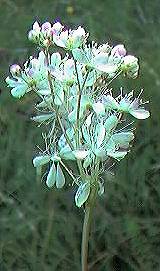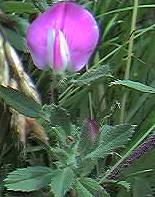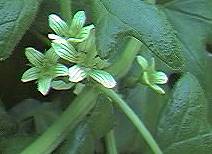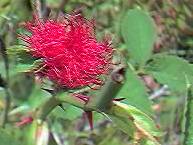 About a dozen members attended this outing. The weather was kind to us after an awful, wintry day on the Monday before. Although it started cloudy the sun gradually broke though so we had sunshine for most of the trip.
About a dozen members attended this outing. The weather was kind to us after an awful, wintry day on the Monday before. Although it started cloudy the sun gradually broke though so we had sunshine for most of the trip.Back to the Index page
[Species lists below]
 About a dozen members attended this outing. The weather was kind to us after an awful, wintry day on the Monday before. Although it started cloudy the sun gradually broke though so we had sunshine for most of the trip.
About a dozen members attended this outing. The weather was kind to us after an awful, wintry day on the Monday before. Although it started cloudy the sun gradually broke though so we had sunshine for most of the trip.
We started in Ellerburn village, which lies in a valley cut through the Tabular Hills, and walked up to the wildlife reserve which lies at the top of the valley-side slope, through the woods and back to the village; some members visited the hide overlooking the pond above the village and the damp meadows around it.
 There is considerable variation in the underlying rocks, with rather acid soils right at the the top of the bank, limestone underlying the meadow of the wildlife reserve, and damper conditions in the valley bottom. The limestone grassland is particularly rich in species, many of them now scarce although they were once common in this area. We did not manage to find the bee orchids which do grow at Ellerburn Banks, but we did see some wonderful pyramidal orchids (left) as well as numerous common spotted orchids (fly orchids and early purples also grow here earlier in the season).
There is considerable variation in the underlying rocks, with rather acid soils right at the the top of the bank, limestone underlying the meadow of the wildlife reserve, and damper conditions in the valley bottom. The limestone grassland is particularly rich in species, many of them now scarce although they were once common in this area. We did not manage to find the bee orchids which do grow at Ellerburn Banks, but we did see some wonderful pyramidal orchids (left) as well as numerous common spotted orchids (fly orchids and early purples also grow here earlier in the season).
I do not have lists of all that was found, but we did record the following: ...and one lizard (briefly!) and a small frog.
Back to the Top
Members saw or heard:
Swallow, Swift, Robin, Mallard, Rook, Magpie, Linnet, Grey Heron, Sand Martin, Goldfinch, House Martin, Kestrel, Chiffchaff, Goldcrest, Woodpigeon, Yellowhammer, Chaffinch, Herring Gull, Willow Warbler, Blackbird, Moorhen, Wren, House Sparrow.
Back to the Top
We recorded 160 plants, a remarkably high number for one day! I have divided them into ferns, flowering plants, trees and shrubs and grasses, sedges and rushes. The lists for grasses and sedges include only those which are easily identifiable or notable.
There were also various exotic trees, including many conifers and a maple which was possibly Sugar Maple, within the forestry plantation.I took a few photos, trying to concentrate on the more unusual plants.
 Pyramidal Orchid |
 Dropwort |
 St. John's Wort |
 Lesser Scabious |
 Great Knapweed |
 Rest Harrow |
 White Bryony |
 Field Scabious |
 Robinís Pincushion |
Back to the Top
Ferns
| English Name | Latin Name |
|---|---|
| Bracken | Pteridium aquilinum |
| Male Fern | Dryopteris filix-mas |
Flowering Plants
| English Name | Latin Name |
|---|---|
| Agrimony, common | Agrimonia eupatoria |
| Angelica (leaf) | Angelica sylvestris |
| Avens, wood (seed) | Geum urbanum |
| Bedstraw, ladys | Galium verum |
| Bell heather | Erica cinerea |
| Betony (?; leaf) | Stachys officinalis |
| Bilberry (fruit) | Vaccinium myrtillus |
| Birdsfoot trefoil, common | Lotus corniculatus |
| Birdsfoot trefoil, greater | Lotus pedunculatus |
| Black bryony | Tamus communis |
| Bramble | Rubus fruticosus |
| Burdock | Arctium minus |
| Burdock | Arctium minus |
| Burnet saxifrage, lesser | Pimpinella saxifraga |
| Burnet, salad | Sanguisorba minor |
| Buttercup, creeping | Ranunculus repens |
| Buttercup, meadow | Ranunculus acris |
| Campion, bladder | Silene vulgaris |
| Campion, red | Silene dioica |
| Campion, white | Silene latifolia |
| Catsear | Hypochaeris radicata |
| Charlock | Sinapis arvensis |
| Chickweed, common | Stellaria media |
| Cinquefoil, creeping | Potentilla reptans |
| Cleavers | Galium aparine |
| Clover, red | Trifolium pratense |
| Clover, white | Trifolium repens |
| Clover, zigzag | Trifolium medium |
| Cowslip (seed) | Primula veris |
| Cranesbill, cut leaved | Geranium dissectum |
| Cranesbill, dovesfoot | Geranium molle |
| Cranesbill, meadow | Geranium pratense |
| Crosswort | Cruciata laevipes |
| Daisy | Bellis perennis |
| Dandelion | Taraxacum sp. |
| Dock, broad leaved | Rumex obtusifolius |
| Dropwort | Filipendula vulgaris |
| Field pennycress (seed) | Thlaspi arvense |
| Figwort, common | Scrophularia nodosa |
| Flax, fairy | Linum catharticum |
| Forgetmenot, field | Myosotis arvensis |
| Gentian, autumn (leaf) | Gentianella amarella |
| Ground ivy (leaf) | Glechoma hederacea |
| Groundsel, heath | Senecio sylvaticus |
| Harebell | Campanula rotundifolia |
| Hawkbit, rough | Leontodon hispidus |
| Hawksbeard, smooth | Crepis capillaris |
| Hawkweed, mouse eared | Pilosella officinarum |
| Heather | Calluna vulgaris |
| Herb robert | Geranium robertianum |
| Hogweed | Heracleum sphondylium |
| Honeysuckle | Lonicera periclymenum |
| Hounds tongue (leaf) | Cynoglossum officinale |
| Knapweed, common | Centaurea nigra |
| Knapweed, greater | Centaurea scabiosa |
| Lords and ladies | Arum maculatum |
| Marjoram | Origanum vulgare |
| Meadow vetchling | Lathyrus pratensis |
| Meadowsweet | Filipendula ulmaria |
| Medick, black | Medicago lupulina |
| Mignonette | Reseda lutea |
| Milkwort, common | Polygala vulgaris |
| Mouse ear, common | Cerastium fontanum |
| Mullein, great | Verbascum thapsus |
| Nettle, common | Urtica dioica |
| Nipplewort | Lapsana communis |
| Orchid, pyramidal | Anacamptis pyramidalis |
| Pignut | Conopodium majus |
| Pineapple weed | Matricaria discoidea |
| Plantain, greater | Plantago major |
| Plantain, hoary | Plantago media |
| Plantain, ribwort | Plantago lanceolata |
| Poppy, common | Papaver rhoeas |
| Ragged robin | Lychnis flos-cuculi |
| Ragwort, common | Senecio jacobea |
| Raspberry | Rubus idaeus |
| Restharrow, common | Ononis repens |
| Rockrose | Helianthemum nummularium |
| Rough chervil | Chaerophyllum temulem |
| Scabious, field | Knautia arvensis |
| Scabious, small | Scabiosa columbaria |
| Self heal | Prunella vulgaris |
| Shepherds purse | Capsella bursa-pastoris |
| Sorrel, common | Rumex acetosa |
| Sorrel, sheeps | Rumex acetosella |
| Sowthistle, rough | Sonchus asper |
| Speedwell, thyme leaved | Veronica serpyllifolia |
| St Johnswort, beautiful | Hypericum pulchrum |
| St Johnswort, hairy | Hypericum hirsutum |
| St Johnswort, perforate | Hypericum perforatum |
| Stitchwort, lesser | Stellaria graminea |
| Strawberry, wild (fruit) | Fragaria vesca |
| Thistle, carline | Carlina vulgaris |
| Thistle, creeping | Cirsium arvense |
| Thistle, marsh | Cirsium palustre |
| Thistle, musk | Carduus nutans |
| Thistle, spear | Cirsium vulgare |
| Thistle, woolly (leaf) | Cirsium eriophorum |
| Thyme | Thymus polytrichus |
| Thyme leaved sandwort | Arenaria serpyllifolia |
| Tormentil | Potentilla erecta |
| Trefoil, lesser | Trifolium dubium |
| Valerian, common | Valeriana officinalis |
| Vetch, bush | Vicia sepium |
| Vetch, kidney | Anthyllis vulneraria |
| Vetch, tufted | Vicia cracca |
| Vipers bugloss | Echium vulgare |
| Wall lettuce (?) | Mycelis muralis |
| White Bryony | Brionia dioica |
| Willowherb, broad leaved | Epilobium montanum |
| Willowherb, great | Epilobium hirsutum |
| Willowherb, rosebay or Fireweed | Chamaenerion angustifolium |
| Wood sage | Teucrium scorodonia |
| Woundwort, hedge | Stachys sylvatica |
| Yarrow | Achillea millefolium |
| Yellow rattle | Rhinanthus minor |
Back to the Top
Grasses, Sedges and Rushes
| English Name | Latin Name |
|---|---|
| Bent, Fine | Agrostis tenuis |
| Brome, Barren | Bromus sterilis (Anisantha sterilis) |
| Brome, Soft | Bromus mollis (Bromus hordeaceus) |
| Cocksfoot | Dactylis glomerata |
| Crested Dogstail | Cynosurus cristatus |
| Hair Grass, Tufted | Deschampsia caespitosa |
| Hair Grass, Wavy | Deschampsia flexuosa |
| Meadow Grass, Rough | Poa trivialis |
| Melick, Wood | Melica uniflora |
| Oat, False | Arrhenatherum elatius |
| Oat, Meadow | Avenula pratensis (Helichtotrichon pratense) |
| Oat, Yellow | Trisetum flavescens |
| Quaking Grass | Briza media |
| Slender False Brome | Brachypodium sylvaticum |
| Sweet Vernal Grass | Anthoxanthum odoratum |
| Tor Grass | Brachypodium pinnatum |
| Yorkshire Fog | Holcus lanatus |
| Common Sedge | Carex nigra |
| Hard Rush | Juncus inflexus |
| Jointed Rush | Juncus articulatus |
| Woodrush, great | Luzula sylvatica |
Back to the Top
Trees and Shrubs
| English Name | Latin Name |
|---|---|
| Alder | Alnus glutinosa |
| Ash | Fraxinus excelsior |
| Beech | Fagus sylvatica |
| Birch, silver | Betula pendula |
| Blackthorn | Prunus spinosa |
| Crab apple | Malus sylvestris |
| Elder | Sambucus nigra |
| Gorse | Ulex europaeus |
| Hawthorn | Crataegus monogyna |
| Ivy | Hedera helix |
| Larch | Larix sp. |
| Maple, field | Acer campestre |
| Oak, hybrid | Quercus sp. |
| Rose, dog | Rosa canina |
| Rose, field | Rosa arvensis |
| Rowan | Sorbus aucuparia |
| Scots pine | Pinus sylvestris |
| Sycamore | Acer pseudoplatanus |
| Wild cherry | Prunus avium |
| Willow, goat | Salix caprea |
| Willow, grey | Salix cinerea |
Back to the Top
We saw a good number of butterflies, especially in the herb-rich meadow, including the following species (there may have been more, but I could not identify them!)
Red admiral
Veined white
Meadow Brown
(Another brown, ?ringlet)
Common Blue
?Marbled white
Small Skipper (right)
There were all kinds of beetles but we could not identify them, several blue damselflies,
...and a Robinís Pincushion (see photo above) caused by a small gall wasp on dog rose.
I saw three fungi: a yellow bolete, probably Larch Bolete, an Amanita, possibly the Blusher, and Jewís Ear on dead Elder.
All photos © copyright 2000 Gill & Adrian Smith
Back to the Top and Index page
© Ryedale Natural History Society 2000